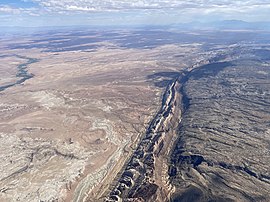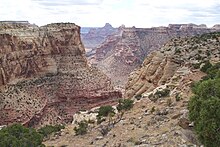San Rafael Swell
| San Rafael Swell | |
|---|---|
 The San Rafael Swell from 16,000 feet | |
| Highest point | |
| Coordinates | 38°48′47″N 110°51′18″W / 38.813°N 110.855°W |
| Dimensions | |
| Length | 75 mi (121 km) |
| Width | 40 mi (64 km) |
| Geography | |
| Location | US |
The San Rafael Swell is a large
.The
Geography

Geology

The San Rafael Swell was formed when deeply buried
Since that time, the relentless force of running water has eroded the geologic layers, resulting in older rocks becoming exposed in the middle of the Swell, and younger rocks exposed around the edges. Many of the most impressive landforms are composed of more resistant rocks, including the Jurassic Navajo Sandstone, Jurassic Wingate Sandstone, and Permian Coconino Sandstone. The folding is much steeper on the eastern edge of the Swell than in the west, and this eastern edge is referred to as the San Rafael Reef.
Both the San Rafael River and Muddy Creek drain out of the high Wasatch Plateau and the cut directly across the uplift of the Reef, which marks them as superimposed streams, pre-dating the time of the uplift. Part of the Swell has geographic features that resemble Mars. The Mars Society decided to set up the Mars Desert Research Station in the area as a Mars analog for such reasons.
Ecology
The San Rafael Swell is an area of high plant
History
Evidence of
The Swell has been used by Hollywood filmmakers as a location setting for alien planets, including the Planet Vulcan in the 2009 film Star Trek and the alien world in Galaxy Quest.
In 2002, Governor
The idea of
In May 2018, US Representative John Curtis put forward a bill to make the area a national monument, to be called "Jurassic National Monument."[4]
San Rafael Recreation Area
The area is managed by the

The following
Cattle grazing is only allowed in parts of the Swell that are not designated as such. The San Rafael Swell is also dotted with sections of land managed by the Utah School and Institutional Trust Lands Administration, as is much of the state of Utah. Goblin Valley State Park is on the southeastern edge of the San Rafael Swell.
Recreation
The San Rafael Swell attracts
The Eastern Reef is a possible destination for rock climbers. It is home to some of the longest and sandiest climbing routes in Southeastern Utah, and was, at least by one person, nicknamed the Sandstone Alps.[7]
Gallery
-
San Rafael Swell, looking westward, with US Interstate 70 passing through.
-
Entrance to theMuddy CreekGorge
-
Eastern slope of the San Rafael Reef
-
Little Grand Canyon
-
The Wedge Overlook of the Little Grand Canyon
-
East side of the San Rafael Swell
References
- ^ Pediocactus despainii. Archived August 29, 2011, at the Wayback Machine Center for Plant Conservation.
- ^ Egan, Timothy (January 29, 2002), "Governor of Utah, in Reversal, Seeks Scenic Area Designation", New York Times, retrieved February 25, 2010
- ^ "Utah Wary Over National Monument Candidate List", New York Times, February 23, 2010, retrieved February 25, 2010 [dead link]
- ^ Jurassic National Monument
- ^ San Rafael Swell Recreation Area - BLM
- ^ "Canyoneering the San Rafael Swell - Route Guide". Climb-Utah.com.
- ^ Achey, Jeff (February 9, 2012). "The Sandstone Alps". Climbing Magazine. Retrieved April 19, 2019.
- Allen, Steve, Canyoneering: The San Rafael Swell, 1992. ISBN 0-87480-372-1
- Durrant, Jeffrey O. Struggle Over Utah's San Rafael Swell: Wilderness, National Conservation Areas, and National Monuments, 2007. ISBN 978-0-8165-2669-7
- Kelsey, Michael R. Hiking and Exploring Utah's San Rafael Swell, 3rd edition, 1999. ISBN 0-944510-17-5






